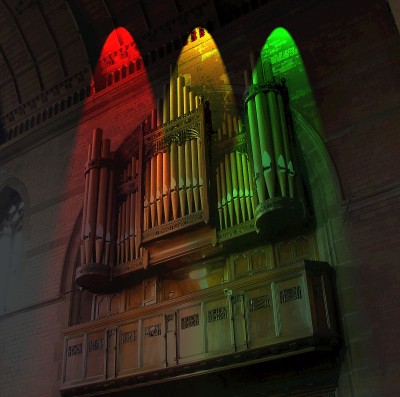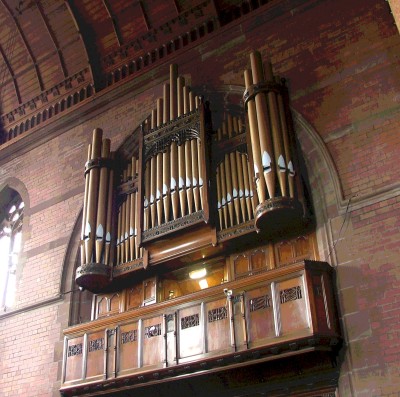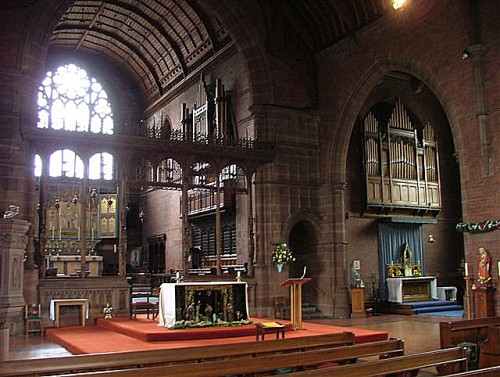
 |

Pulling out all the stops: the organ
at St Faith's
The article
below, written in 1988, describes the orgins and
features of our instrument.
For a contemporary account of the
organ's installation, features and opening recital,
click HERE
The consecration of St Faith’s Church took place on April 21, 1900. Although the church was dubbed ‘a half-way house to Rome’ and ‘this Mass House’ by local Protestants, the building - as described in the 1975 history of the church - was very plain by comparison with the building as we see it now. There was no reredos, no nave altar, no chancel screen, no Lady Chapel. There was also no organ - an orchestra was used for the service. It was not until the August that the organ was ready for use.
The instrument was built by J.W.Walker and Sons Ltd, and consists of two manuals (Great and Swell) and pedal organ. For the uninitiated, our organ is really three instruments in one: firstly there is the Great Organ, which consists of several rows of pipes (called stops) and is situated at the front, overlooking the choir stalls and the Lady Chapel, visible to the congregation. These pipes produce the weightiest sound and are operated by the Great Manual, the lower of the two manuals (or keyboards). Secondly, there is the Swell Organ, consisting of several rows of pipes which are contained in a huge wooden box (the Swell box), behind the Great Organ pipes. At the front of this box are shutters, rather like Venetian blinds. Operated by a pedal near the player’s feet, these blinds open and shut to vary the volume of sound. The Swell Organ is operated by the upper manual or keyboard. Finally there is the Pedal Organ, consisting of much larger pipes which give depth to the sound canvass. These are brought into play by the pedal keyboard (2.5 octaves in compass) played by the feet.
Pipe organs need regular tuning and maintenance, and from time to time repairs and overhauls. In 1950 a new pedalboard was installed to replace the old, worn-out one. A plaque by the console tells us that it was given as a thank-offering by the congregation as part of the Jubilee Celebrations. A Parish Magazine from 1951 reports: ‘It was pointed out at a PCC meeting that the financial commitments of the future were bound to be heavy. We have been informed that the organ will need to be taken down, repaired, cleaned and re-assembled within the next year or so.’
Some of this work was done when, as a result of an appeal, money was raised in memory of Fr William Hassall: a plaque in the choir stalls bears witness to this. By the 1980’s the organ was beginning to show signs of serious wear. The action of the keys was heavy and noisy - up to now the Great Organ was operated by tracker action, in which metal rods mechanically linked the keys to the windchests. As organist, I was finding pieces like the Widor Toccata increasingly difficult to play, not just through lack of practice! It was time for a complete overhaul and electrification to take place.
Ian Tracey, in his capacity as Diocesan Advisor, came to inspect St Faith’s organ in November, 1987. Dressed in white boiler suit (complete with the Cathedral crest, of course!) he clambered into the bowels of the instrument, armed with a dictaphone. Ian was very impressed with the quality of the ‘super little instrument at St Faith’s’, as he put it, with its pipe work still in remarkable condition. In his words, the organ was a ‘Rolls Royce’ of its kind.
There were problems, however, the main one being the fact that most of the 100 or so pipes were stuck away in an unusually large chamber behind the North Chance! walls. It was not surprising that there was an appreciable loss of volume by the time the sound reached the nave. Recommendations were made, including an overhaul and cleaning of the air reservoirs, complete electrification of the action and the addition of a trumpet stop and mixture stop, to add strength and brightness to the sound (the trumpet is situated facing the Lady Chapel, behind the front pipes - you will certainly be aware of it during the last verse of hymns!).
The most radical suggestion was to move sections of the organ around. This was actually done: the Swell Organ was moved forward by about 9 feet, and some pedal pipes were moved to the side, overlooking the Lady Chapel behind the trumpet stop.
This major work took place in 1988, by David Wells’ team, and for several months the organ was out of action. During that time, I used a Casio keyboard from the choir stalls, wired up to the amplification system. This setup provided the congregation with amusement more than once, when the rhythm decided to pound forth during the odd hymn or voluntary!
I watched the progress of the organ’s major surgery with great interest, although it was quite sad to see parts of it in bits, as great lengths of twisted metal lay strewn in the chamber waiting to be replaced with electrical wire. After the work was completed, Ian Tracey gave the opening recital on the restored organ on Saturday, 23 April, 1988, including works by Bach, Guilmant, Albinoni and Handel. It seemed a fitting climax to an ambitious and costly programme.
We now have a brighter, better organ to enhance our liturgy and concert events. I hope that we will continue with the will to maintain and develop the organ for future generations. The work undertaken in 1988 began to address the problem of the appalling loss of sound. I hope that we shall not regard it as the final word, but that in the future we might consider expanding the instrument further. There is plenty of room for more stops to be added to give the organ more power. Meanwhile, let us be grateful for the beautiful tonal qualities of the ‘super little instrument’ at St Faith’s.
Iain Harvey
 |
 |